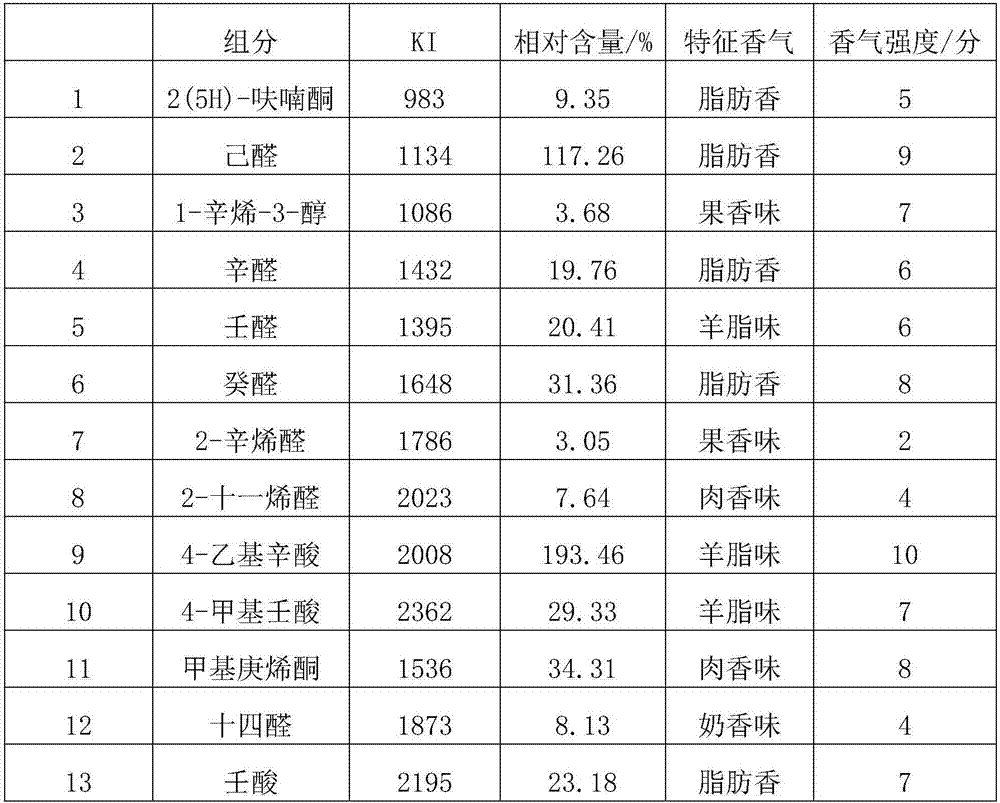Rapid identification method of aroma quality of minced mutton
A technology for mutton sausage and aroma, which is applied to measurement devices, instruments, scientific instruments, etc., can solve the problems of increasing qualitative analysis errors, undetermined standard components, and long identification time, and achieves the effect of comprehensive identification.
- Summary
- Abstract
- Description
- Claims
- Application Information
AI Technical Summary
Problems solved by technology
Method used
Image
Examples
Embodiment 1
[0021] Step 1: Put mutton saozi into a headspace solid-phase microextraction bottle, and after 0.5h in a constant temperature water bath at 50°C, insert the aged 75μm CAR / PDMS extraction head into the bottle, and perform equilibrium adsorption in the headspace at 45°C for 30min;
[0022] Step 2: Move the extraction head in step 1 to the gas chromatograph interface, analyze at 200°C for 10 minutes, and then flow the effluent into the mass spectrometer and olfactory instrument at a split ratio of 1:1 for mass spectrometry analysis;
[0023] Chromatographic conditions: the capillary column is a DB-WAX column (30m×0.25mm×0.25μm), the injection port is 250°C, the interface is 250°C, the initial column temperature is 35°C, keep it for 2min, and raise the temperature to 75°C at 6°C / min. Then raise the temperature at 10°C / min to 220°C and keep it for 6min, the carrier gas is He, the column flow rate is 0.6mL / min, splitless;
[0024] Mass spectrometry conditions: ionization mode EI, el...
Embodiment 2
[0030] The operation is the same as in Example 1, wherein, Step 1: 55°C constant temperature water bath for 1.0h, 50°C headspace equilibrium adsorption for 30min; Step 2: 250°C analysis for 12.5min, chromatographic conditions: initial column temperature 40°C, hold for 3min, first Raise the temperature to 80°C and then to 230°C, the column flow rate is 0.8mL / min, mass spectrometry conditions: ion source temperature 200°C, interface temperature 350°C, filament emission current 200μA; Step 3: Repeat 5 times.
Embodiment 3
[0032] The operation is the same as that of Example 1, wherein, Step 1: 60°C constant temperature water bath for 1.5h, 50°C headspace equilibrium adsorption for 30min; Step 2: 300°C analysis for 15min, chromatographic conditions: initial column temperature is 45°C, keep for 4min, first raise the temperature Heat up to 85°C and then raise the temperature to 240°C, column flow rate is 1.0mL / min, mass spectrometry conditions: ion source temperature 250°C, interface temperature 400°C, filament emission current 220μA; Step 3: Repeat 6 times.
[0033] Calculate the average KI value, average relative content, and average sensory evaluation value of the characteristic aroma components of mutton saozi identified in Example 1, Example 2, and Example 3, and summarize them into Table 1.
[0034] Table 1 Fingerprint information of characteristic flavor active substances of mutton saozi
[0035]
[0036]
[0037] Based on the above table, it can be concluded that the components contri...
PUM
 Login to View More
Login to View More Abstract
Description
Claims
Application Information
 Login to View More
Login to View More - R&D
- Intellectual Property
- Life Sciences
- Materials
- Tech Scout
- Unparalleled Data Quality
- Higher Quality Content
- 60% Fewer Hallucinations
Browse by: Latest US Patents, China's latest patents, Technical Efficacy Thesaurus, Application Domain, Technology Topic, Popular Technical Reports.
© 2025 PatSnap. All rights reserved.Legal|Privacy policy|Modern Slavery Act Transparency Statement|Sitemap|About US| Contact US: help@patsnap.com


